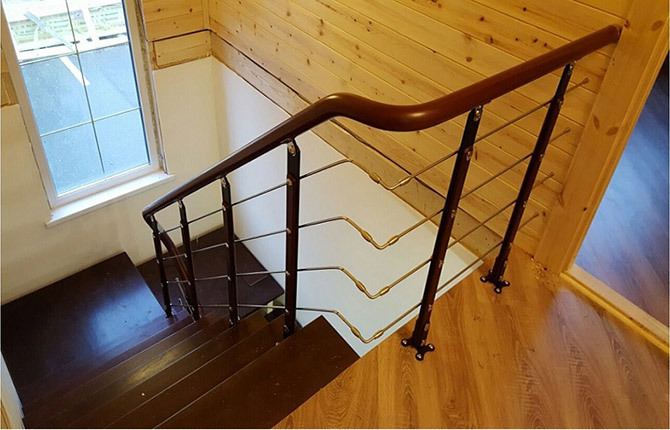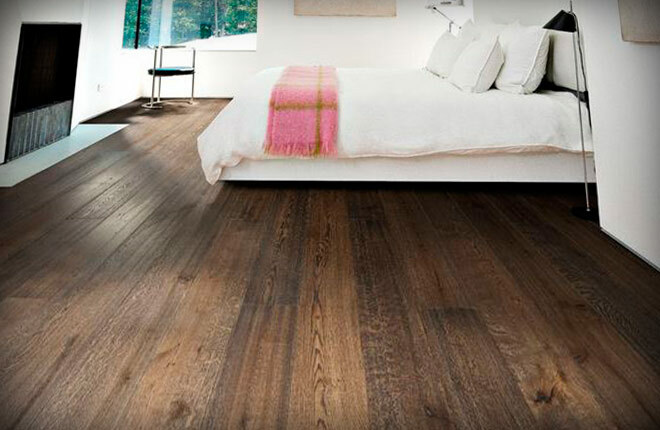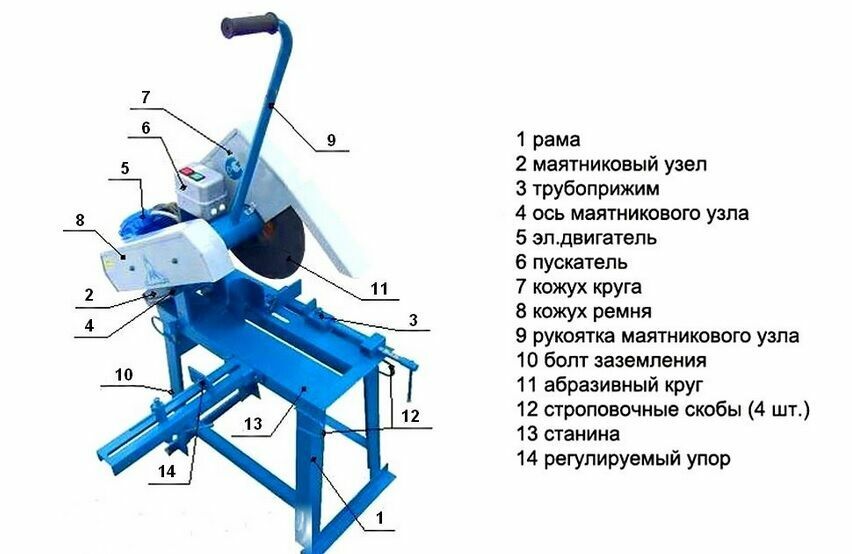Choosing the right material for the floor has always been difficult, even if there are certain preferences. Most often, the flooring is seen as wooden or from a material resembling natural wood in properties. What to lay, parquet board or laminate flooringWhat is the difference between parquet and laminate? There are many nuances, and you can get confused.
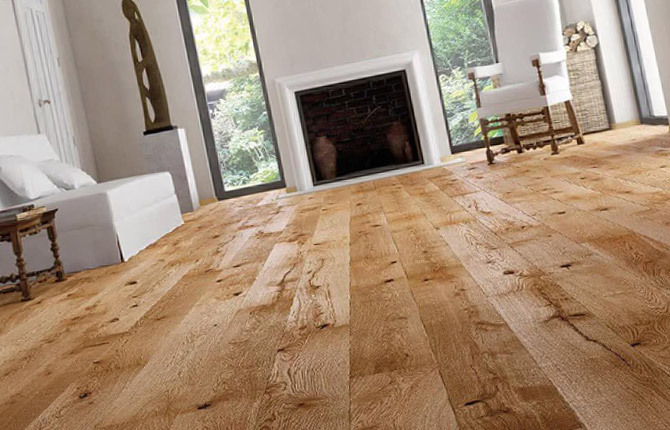
The content of the article:
-
What is the difference between parquet board and laminate
- Pros and cons of laminate
- Pros and cons of parquet board
-
Detailed comparison
- Price
- Installation
- Which floor is easier to disassemble
- What is more durable
- combustibility
- Strength
- Which material is more wear resistant
- Humidity resistance
- What is warmer
- Noise isolation
- Care
- Environmental friendliness of the material
- Which one is better for underfloor heating?
What is the difference between parquet board and laminate
In fact, these are 2 different types of flooring, only outwardly similar in design. The main difference between parquet and laminate is the manufacturing method. Different technologies and materials used. Although after laying on the floor it can be difficult to determine the difference between parquet and laminate, there are differences, and significant ones.
Laminate is pressed cellulose fibers. Parquet is different in that the upper front part is always made of natural wood.
Differences:
- Parquet boards can be from several layers, but there are options when the parquet (planks) are cut from one solid wood. Laminate is always distinguished by a multi-layer structure.
- Lamellas (laminate boards) can be up to 6 m long, up to 40 cm wide, parquet is produced in boards from 70 mm to 180 mm, with a maximum length of 250 cm. If these are square panels, then 40x40 cm or 60x60 cm.
- The top layer of parquet is always wood, most often glued veneer with a thickness of 2.5-5 mm. In laminate, this is a thick polyester or polyurethane film glued to a base of pressed cellulose fibers;
- The parquet board is very thick, thinner than 13 mm is almost never found, usually 25 mm. Laminate can be up to 12 mm.
In inexpensive brands of laminate, fiberboard can serve as the basis, in cheap ones - chipboard. For an expensive laminate, a special base is used from pressed fibers impregnated with a silicone binder. As a result, the material acquires increased flexibility, does not absorb water, and most importantly, the locks are highly durable.
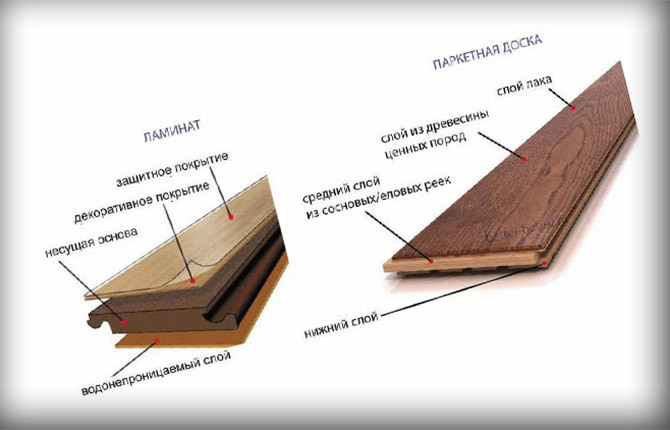
Inexpensive brands of parquet (rustic or country class) are oak veneer glued to heat-treated pine. High-quality parquet (Select class is cut from individual sections of a log) is almost always piece, with individual adjustment of the boards according to the color of the fibers and dimensions. It can be made of oak, beech, but more valuable species can also be used - wenge, African oak, cork tree.
The only thing that both floor coverings have in common is the installation method. Necessarily on a substrate, the flooring can be glued to the floor or assembled on specially designed end locks.
There is also a difference between parquet and laminate in terms of service life. If we compare in terms of durability, then the parquet floor will be the leader. Piece or type-setting parquet (laid from boards 40x250x18mm) is distinguished by endurance and wear resistance. It can last up to 40 years. Good quality laminate flooring will last 12-15 years.
Pros and cons of laminate
The material is simple and light. Sometimes laminate is mistakenly referred to as office flooring, but this is not entirely true. It can be found everywhere, it is affordable, thanks to the huge selection of colors, the popularity of the material is huge. The only place where laminate floors are not laid is the premises of shopping centers.
Another significant plus of the laminate is that the material forgives small flaws when laying. This means that the flooring can be laid by hand without compromising quality.
Of the important 2 disadvantages - laminate floors are not highly resistant to spilled water. Wetting often causes the entire coating to be replaced. Laminate can be repaired only in small areas, by replacing 1-2 lamellas.
The second minus is the creak that appears if the lamellas were laid on an incorrectly cut substrate. Dealing with creaking floors is difficult. As a rule, squeaking means that the locks do not work to fix the flooring. So not for long and break the tenon-groove connection.
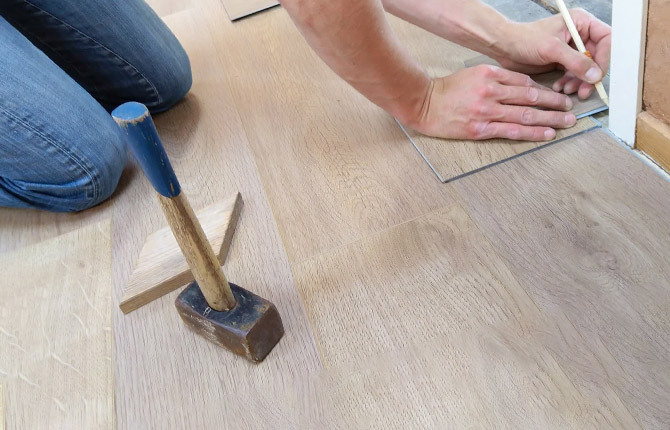
Laminate is easier to replace or maintain. If necessary, the floor can be disassembled and tried to dry. But such a solution is possible only for high-quality waterproof slats. Cheap brands, as a rule, do not differ in durability.
There are special brands of laminate with a heat-resistant coating and rubberized locks. After assembly, such a material withstands contact with spilled water for half an hour, and a film of polyurethane is characterized by high heat resistance, it can easily withstand a fallen lit match or even candle.
The wear resistance of the top coating is so great that the material can be used in crowded places, where a tile or concrete floor is usually made.
Pros and cons of parquet board
Parquet is classified as a representative type of flooring along with piece tiles made of natural stone or inlaid mosaic flooring. Even 20-25 years ago, parquet flooring could only be laid out in typesetting from a sawn plank 50x320x22 mm in size.
At the same time, laying the coating was laborious and required the skill and experience of the master. Such a floor served with an appropriate level of care for 30-40 years.
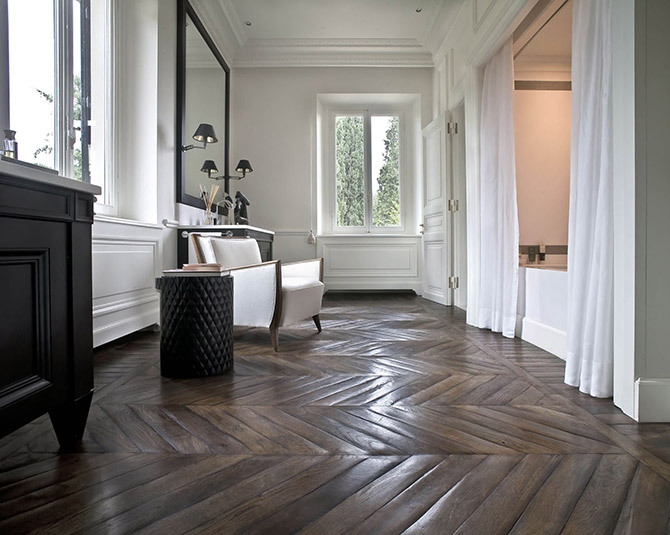
Disadvantages of modern parquet boards:
- Most brands of parquet, even expensive branded ones, are machine-cut boards, glued and veneered using furniture technology. Therefore, modern parquet flooring is cheap and affordable for the average consumer.
- The selection of material for parquet boards is made from ordinary wood. There is no selection according to the place where the tree was grown, the age and structure of the fibers. Even the Select brands are just a high-quality array cut from a certain place on the trunk. Accordingly, the quality of such parquet differs from the generally accepted opinion about the strength and wear resistance of parquet flooring.
- The use of a large number of impregnations and adhesive compositions to improve the mechanical properties of parquet boards. Instead of traditional harmless wax mastics and oil polishes, paintwork materials of complex chemical composition are used.
- In appearance, modern parquet differs little from the best brands of laminate and is even inferior in the variety of fiber patterns.
However, the parquet floor has several positive qualities, thanks to which it is in demand and popularity. Walking on it is much more pleasant than on laminate flooring and even more so on linoleum. Parquet, if it gives a certain amount of dust (due to wear and tear of wood), then it is harmless. Parquet flooring is characterized by a low level of electrostatics, which means that dust does not stick to it, as it does to synthetic floor coverings.
With proper care, natural parquet lasts a long time, does not lose color and surface texture. Moreover, a high-quality parquet floor differs from synthetics in the ability to restore the color and pattern of wood fibers.
Detailed comparison
The easiest way to choose the best option is to compare both floor coverings of approximately the same class, select the points in which they differ, and determine the most important positions.
Price
Parquet will always have a higher price. Laminate production technology is much cheaper. In fact, this is a strip of fiberboard, on which a decorative film with a pattern of fibers is glued with further hot pressing of the film (or several layers of MDF varnish). It is not difficult to understand what is cheaper, if only because the laminate can be considered an imitation of a parquet board.

Laminate production is omnivorous. Products of different classes differ only in the thickness of the film (the number of layers), the design of the docking locks and the presence of a silicone seal in the tenon-groove system and the back side of the base.
The manufacture of parquet boards is a complex technological process. The blanks are sorted so that adjacent boards or glued veneer differ in color or pattern of fibers by no more than 1-2%.
Installation
The laminate floor assembly system makes it possible to lay the lamellas with your own hands, without outside help. Panels of different brands and brands may differ in the arrangement of end locks, but almost always the procedure is the same:
- The first lamella is laid on a substrate or directly on the floor with glue applied.
- The second board is tilted at an angle (45-60O) to a horizontal surface, engage with the already laid panel and transfer to a horizontal position.
- After tamping the end with a wooden hammer through a rubber spacer, you can move on to the next lamella.
Before laying laminate or parquet, the surface must be planned and leveled so that the height difference per 1 linear meter is no more than 2 mm. Then a substrate of polyethylene or pressed needles is laid.
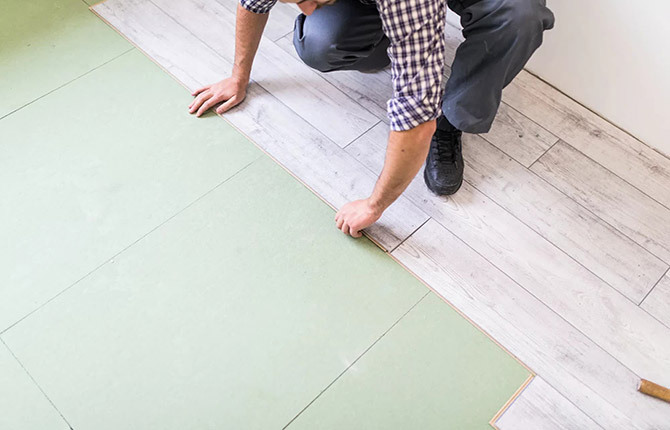
Laying parquet is more complex. Ordinary parquet boards are also laid on the substrate, but the requirements for the base are stricter. Moreover, you need to choose the right shades, since within the same batch there may be parquet boards that differ in the saturation of the pattern. The defect can only be seen after installation.
Strip parquet is the hardest to install. The dies are glued to the mastic or to a special viscous composition. At the end, they cycle with a grinder, open with varnish. This floor is extremely durable.
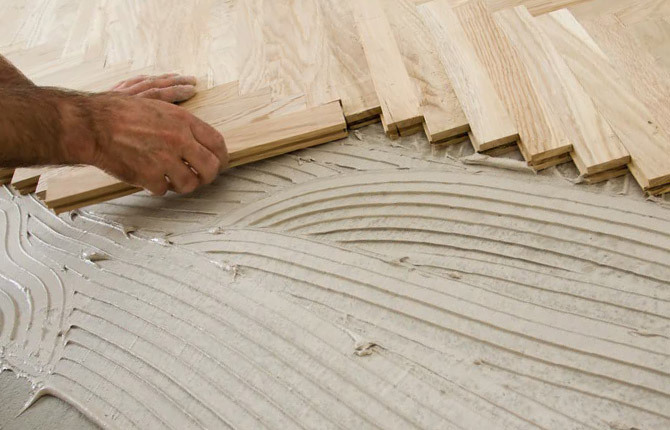
Which floor is easier to disassemble
Inexpensive laminate can be disassembled 1-2 times maximum. The process is simple, you need to act in the reverse order of assembly. If you try to disassemble for the third time, then half of the locks will be broken. Some high end brand name laminates (Grade 33) cannot be dismantled and re-installed, but there are models of high-quality laminate coating, where the design of the locks allows you to open the connection and disassemble lamellas.
It is easier to dismantle the unglued parquet on the underlay, but it can be difficult to re-lay the board. Locks on a parquet board are different from laminate ones, and as a rule, they are not designed for reuse. Therefore, the second time the parquet will have to be glued to the floor.
What is more durable
With proper care, solid wood parquet flooring can outlive 2-3 generations of quality laminate flooring. Especially if it is oak or beech, wenge, ebony. Ordinary veneered parquet on a plywood base lasts no longer than a high-quality laminate.
Parquet can be considered more durable due to strong locks, but again, only with care and periodic treatment of the coating with protective mastics. If you do not take care of the parquet board, then cracks quickly appear on the end surface, which leads to the destruction of dies and panels.
Laminate is distinguished by the fact that it does not require special care - it is enough to lay the material correctly and although Once a year, cracks should be treated with protective waxes that prevent the accumulation of dirt and water in castles.
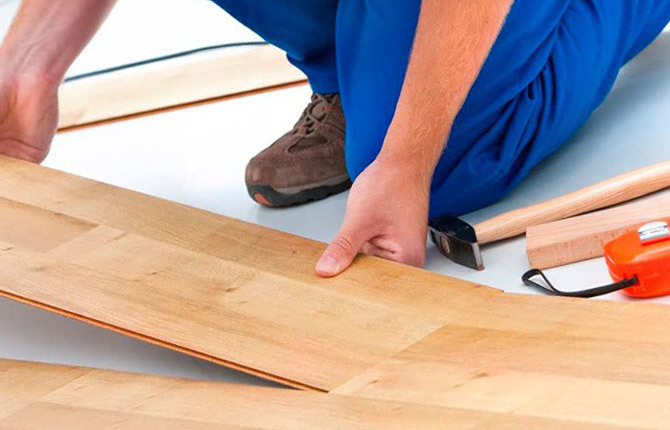
combustibility
Due to the high content of pure cellulose fiber, the slats are less resistant to open fire and hot objects. The limiting temperature is considered to be up to 120 ℃, after which the softening and swelling of the protective film begins.
With short-term contact even with open fire, the laminate has a noticeable endurance. If you drop a hot iron, soldering iron or a lit candle (match) on the floor and pick up the object for a few seconds, then only a dark spot will remain on the surface.
Laminate burns better than a plank floor or parquet, so you can’t put a potbelly stove or an apartment fireplace on the floor.
Parquet is highly resistant to heat - it does not burn, even if the process of charring of wood or plywood base has begun. But keep in mind that all brands of parquet boards (except piece) are impregnated with special compounds.
Therefore, when the coating burns, a huge amount of toxic gases (including carbon monoxide) are released, causing suffocation and even poisoning.
Strength
If compared in terms of fatigue strength, then the laminate will be more durable. Due to the more elastic base, laminate panels are flexible. This means that slightly uneven flooring and improperly placed furniture will cause the floor to slam or creak. In extreme cases, a small bubble will appear, but the laminate will remain intact.
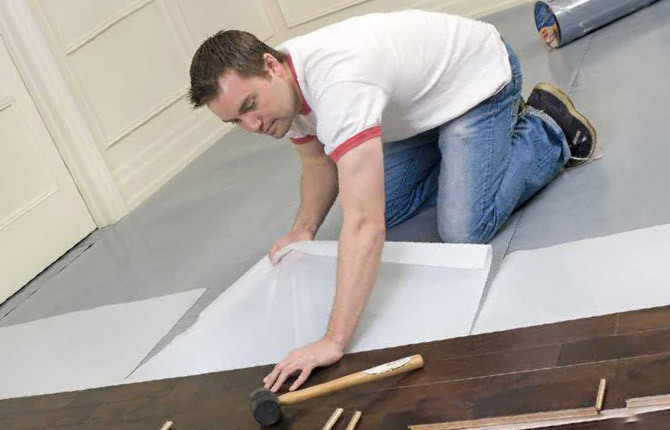
Parquet does not forgive mistakes - if the coating is "hanging" in the air even in a small area, then the result will be broken locks at the joints.
On the other hand, parquet flooring has a high contact strength. On top of the coating, you can install a heavy cabinet with thin legs, even a cast-iron bath, and the wood will withstand the pressure. Especially if it is piece parquet.
Laminate has low contact strength - incorrectly placed furniture can cause the lock to break.
Which material is more wear resistant
It is possible to compare 2 types of flooring only within the same wear resistance class:
- The heaviest laminate (for cafes, mini markets, offices) class 33 is highly wear resistant. It is higher than that of a good panel parquet with additional surface varnishing.
- Middle class laminate, 31-32, roughly corresponds to the characteristics of a high-quality parquet flooring. It is used in apartments and private houses as the main floor covering.
- Budget-class parquet is superior to inexpensive laminate flooring in all respects.
It should be borne in mind that the wear resistance of parquet largely depends on 2 factors - the nature of the wood and the care of the coating. It is difficult and not always possible to restore the protective film on laminate, while parquet can survive several major repairs to restore the appearance and texture of the surface.
Humidity resistance
For parquet, any contact with moisture is undesirable, this differs from floorboards or fiberboards. Even if the flooring is regularly looked after, treated with mastic or wax, water spilled on the floor finds cracks and flows under the base. But this takes at least 10-15 minutes.
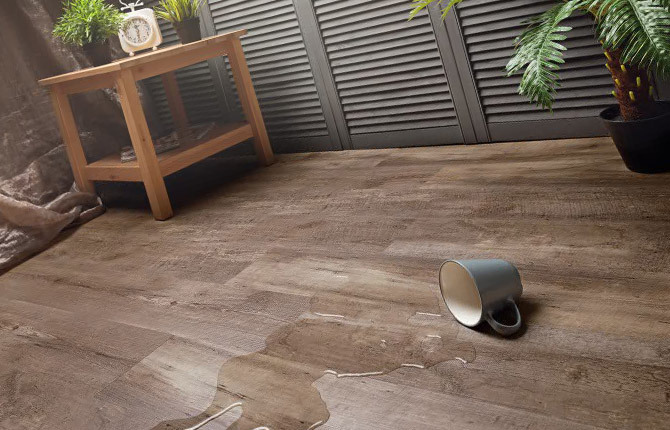
If a washing machine has leaked, or a container of water has been overturned on the parquet, then you must immediately remove the liquid from the surface and, if possible, dry the floor. If the neighbors flooded the apartment or the roof leaked, then the parquet should be urgently dried, and most likely some part of it should be re-laid.
Conventional laminate brands also do not tolerate contact with water, perhaps even worse than parquet. But waterproof models of laminate flooring with rubber seals in the locks can stand in water for an hour for a new floor and 20-30 minutes for an old worn floor without damage.
What is warmer
Definitely a laminate floor will retain heat better due to the lower thermal conductivity of the material. In addition, a thick cork or coniferous substrate (8-12 mm) can be laid under the laminate. In this case, you can even walk on the floor with bare feet, even if the material is laid directly on the concrete floor slab.
Parquet is colder, dense and heavy wood conducts heat better. A thick substrate under the panels can not be laid.
Therefore, plywood rough floors are used for concrete bases, or, alternatively, cork parquet can be laid. He is not afraid of water, and the thermal conductivity is even lower than that of a laminate on the thickest substrate.
Noise isolation
Parquet is definitely the most "voiced" material. In terms of sound insulation, it is inferior not only to laminate, but even to ordinary PVC tiles. If the neighbors laid parquet from above, then not only steps will be heard, but even the sound from an object that has fallen on the parquet floor.
Cork flooring has good sound insulation, while oak, beech, ebony floorings are very noisy. Sometimes, to dampen noise, the joints between the boards are treated with a silicone compound - this makes it possible to reduce the noise level by 20%.
Laminate also may not have good sound insulation, for example, if the material is glued to a concrete floor without a substrate. But such schemes are used mainly in cafeterias and public institutions, where it is important to extend the service life. Oddly enough, but without a soft base, the laminate lasts longer.
Care
High-quality laminate requires minimal maintenance, 1-2 times a year you need to clean the joints from accumulated dust and treat with silicone oil to squeeze moisture out of the locks.
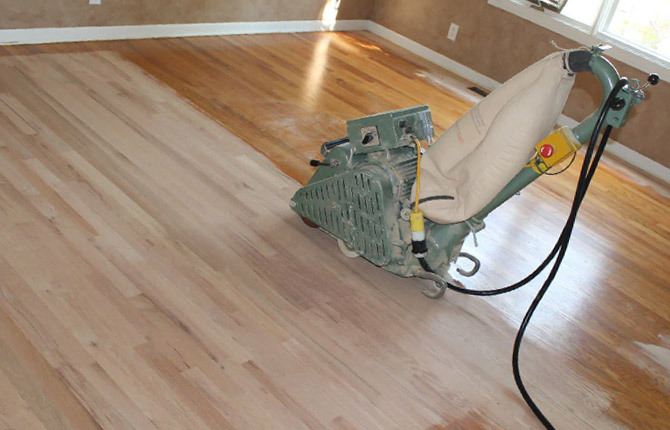
Budget stamps after 3-4 years of service are periodically opened with a special polyurethane varnish. This allows you to partially restore the protective film and close the joints from moisture.
After wet cleaning, the laminate flooring must be dried. If it is a warm floor, then the heating power is increased to 80% within 20-25 minutes. On ordinary floors, it is enough to open a window and a door for a draft (even cold air) to dry the coating.
Caring for ordinary parquet involves the treatment of joints and wax mastic at least once a month. Strip parquet is characterized by high maintenance requirements. At least once every two weeks, you will need to rub the floor with mastic, and if necessary, polish the surface. This treatment guarantees reliable protection against scratches and moisture.
Once every 5 years, the surface of piece parquet is cycled or polished to level the plane. As the top layer of wood is abraded, “paths” form on the surface, in addition, edges rise on the planks themselves, which need to be cut.
But these requirements most often apply to old and budget brands of parquet flooring. For example, the floor is made of ebony, wenge does not cycle. It is highly resistant to abrasion, so the first repair, if necessary, can be carried out no earlier than after 15 years of operation.
Environmental friendliness of the material
Parquet is definitely considered a cleaner and safer flooring. Especially if these are piece dies, and not boards glued together from several different types of wood. The parquet floor is distinguished by the fact that the front part of the wood is practically not subjected to deep processing.
Excluding thermal drying or pressure sealing. All other surfaces are treated with protective impregnations. But after assembly, they remain closed and do not pose a danger to humans.
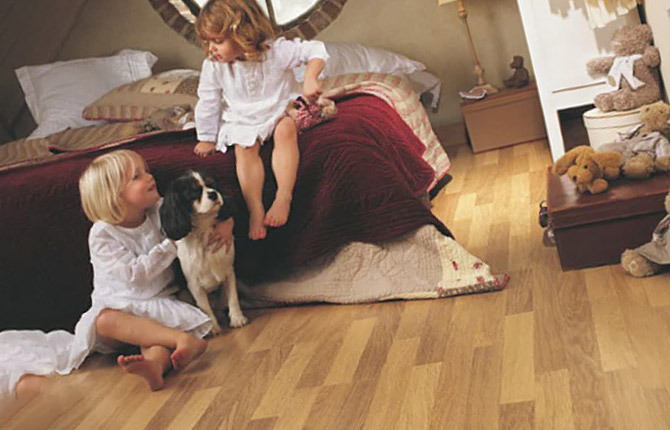
Laminate is the opposite. The outer layer is a polymer film and paper with a printed texture and coloring of the fibers. Both materials pass sanitary and hygienic control, so there is nothing to fear.
Sometimes, on inexpensive brands of laminate, dust appears, which is thrown out by a stream of air through the locks from the surface of the concrete.
Coatings laid on the cheapest polyethylene foam substrates are distinguished by such problems. There is no dust formation on cork or coniferous lining materials.
Which one is better for underfloor heating?
The thermal conductivity of parquet is slightly higher than that of laminate. Therefore, the coating of the boards is better suited for arranging a warm floor.
In addition, the structure of the parquet floor is characterized by a large number of dies and joints between them. This means that, due to the large number of joints, the parquet flooring is more plasticity and will not “bubble” when heated strongly, for example, when using a cable system floor heating.
For laminate, lighter systems based on carbon film are recommended.
But parquet boards have one drawback - they are distinguished by a large coefficient of thermal expansion. With strong and prolonged heating, wood, even thermally stabilized and varnished, can change dimensions and even crack. Therefore, when choosing which is better for a warm floor, you need to consider the heating scheme.
To understand how parquet differs from laminate, you can only from your own experience. The most complex and capricious character of the parquet floor. Therefore, the selection of boards, laying the material and caring for it must be approached carefully. A laminate can be considered as a temporary replacement. While most modern laminate flooring isn't all that different from cheap parquet.
What would you choose? Share in the comments. Bookmark the article so that useful information is always available.
